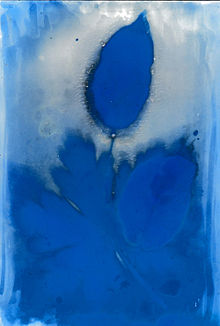Anthotypia

The anthotype (from Greek. Άνθος anthos "bloom" and τύπος typos "imprint", also called Nature Printing referred to) is a photographic precious printing method , which on the color change of plant dyes upon exposure to light (. E.g., UV light is based).
This process was probably discovered in 1816 by Henri August Vogel in Paris. Even Sir John Herschel looked in the 19th century with the anthotype and published his results.
Alcoholic extracts from suitable plant varieties that contain anthocyanins such as poppies , chrysanthemums , dahlias , marigolds and the like. a. are applied to thicker paper that is not too absorbent. Color extracts with water and fruit extracts are also possible. After drying, exposure is carried out for a long time (sometimes for weeks) under a negative or object. The most effective ingredient is ultraviolet light. The plant dyes exposed to light fade out, while the light-protected areas retain their color. (Some plant dyes also darken when exposed to light.)
The required duration depends above all on the specific dye and the sunlight, but also on moisture, which in some cases greatly reduces the necessary exposure time. In the presence of moisture, plant material used as a template can also decompose itself.
The created images (or photograms ) can only be stored away from light as they cannot be fixed. Then they can be kept for a very long time.
Film positives on transparent film can be used as templates, since light areas become light due to fading and dark areas remain dark due to shading. Objects such as leaves, stones, combs and many others can also be used as templates. The result is then a photogram.
Because of the long exposure times, there was no industrial or commercial use.

